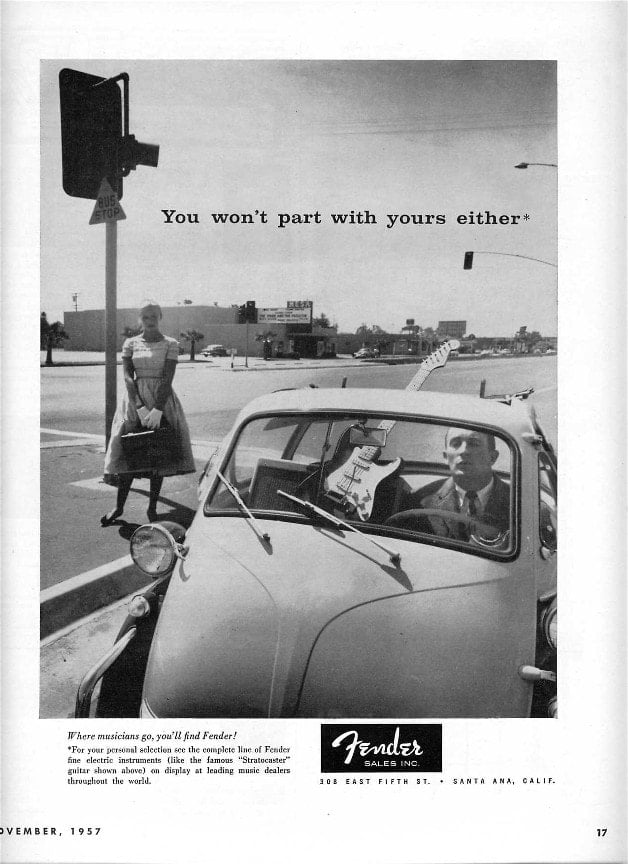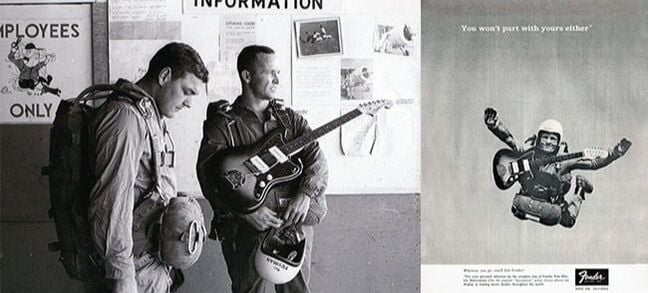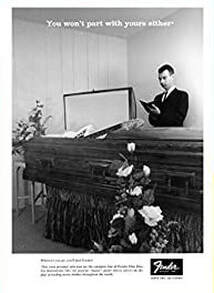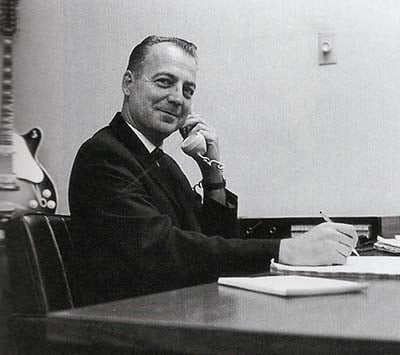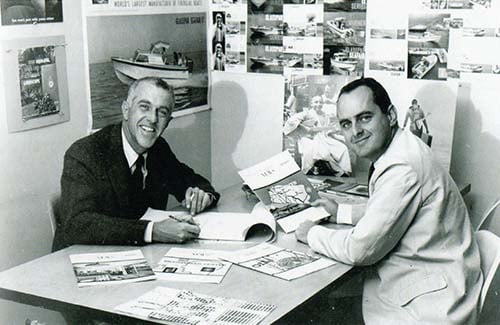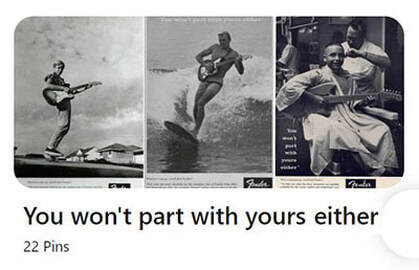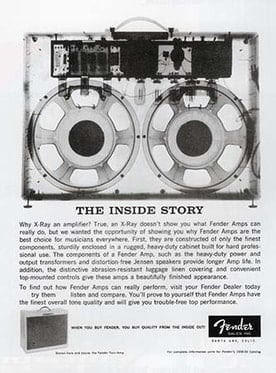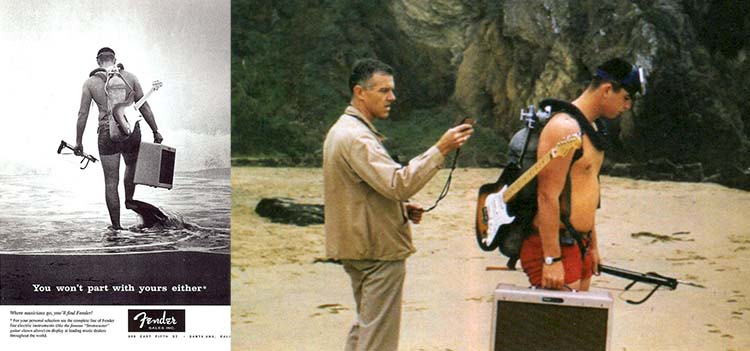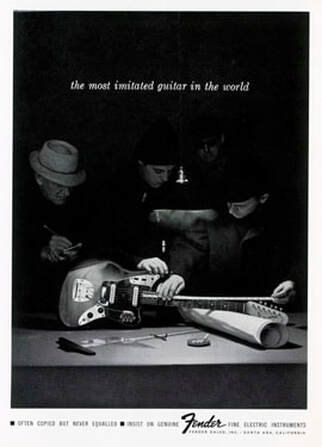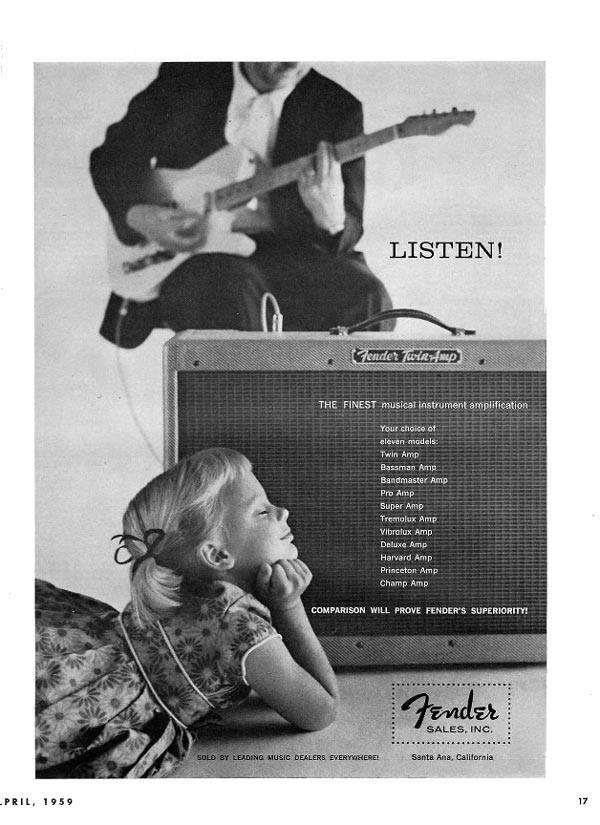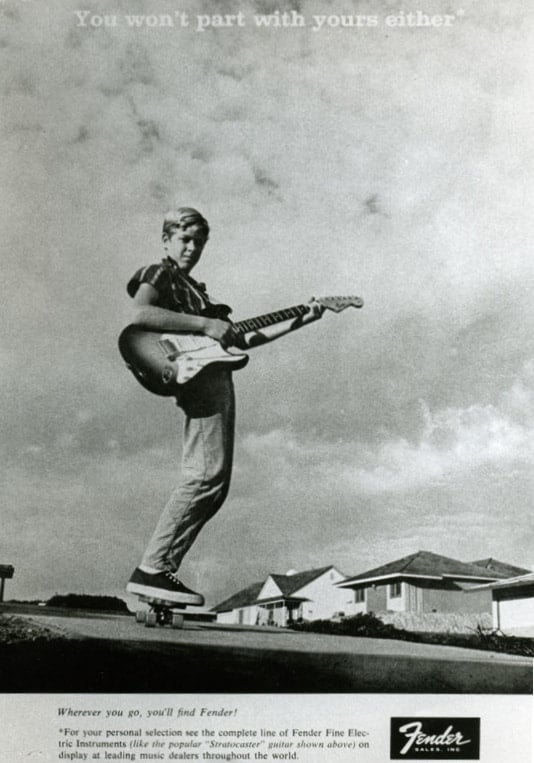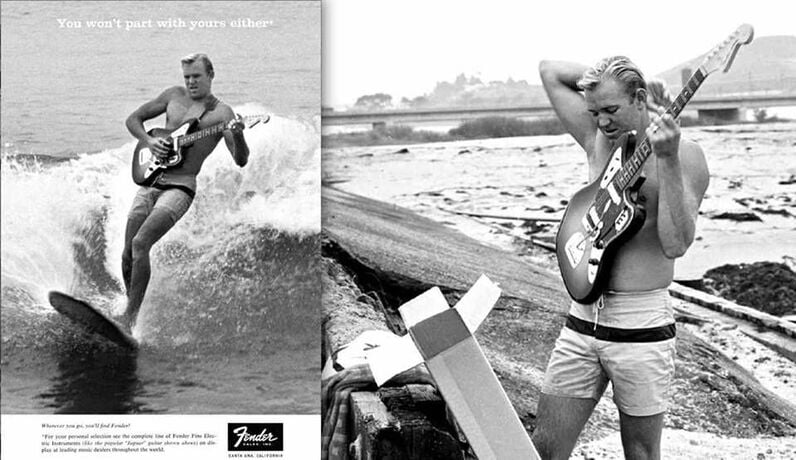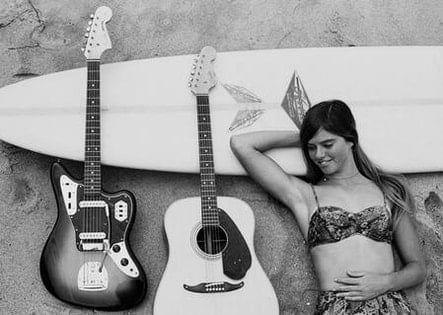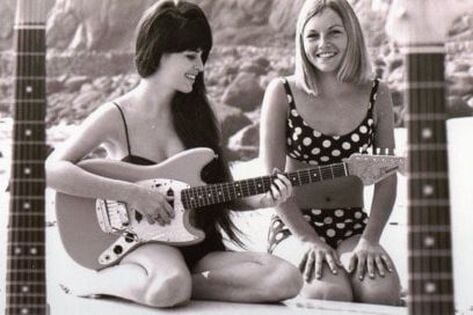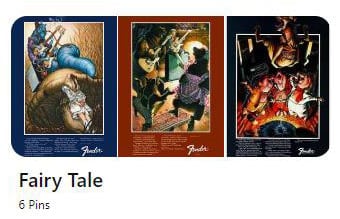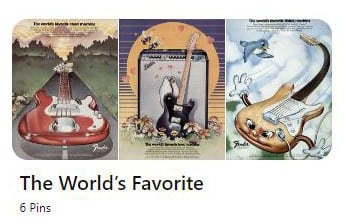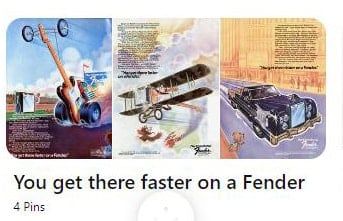YOU WON’T PART WITH YOURS EITHER & OTHER PERINE/JACOBY VINTAGE FENDER ADS
“You Won’t Part with Yours Either” by Perine/Jacoby agency was one of the highly successful and historically important promotional campaigns for Fender Musical Instruments. It expressed the love affair relationship a musician developed with his instrument which, in a sense, was his best friend, surely his voice, if not his lover, and played with this idea of attachment run amok depicting musicians of all ages unwilling to leave their precious Fender guitars unattended.
Every advertisement showed people carrying Fender instruments in a host of unlikely settings—while surfing, dancing, playing football, skydiving, scuba diving, and other unusual situations. One depicted a man lying in his coffin holding a Fender! The president of Fender Sales, Don Randall, saw the humor but felt that the advertisement was a bit too extreme, and it never ran.
Perine/Jacoby was an agency based in Newport Beach that, between 1957 and 1969, produced very clever and modern advertising, catalog, and graphic work for Fender. Their artfully youthful vision helped Fender grow from a regional guitar maker to an industry giant.
|
From 1946 to 1953 Fender ads were designed or closely supervised by Don Randall himself, but the results were inconsistent because a reluctant Francis Hall, owner of Radio-Tel, exclusive distributor for Fender products until early 1953, limited how many ads actually ran.
When Fender Sales was established in 1953, Randall increased advertising in magazines such as Music Trades, International Musician, and Down Beat, using designers for specific jobs. In 1955 Don hired Stanley Compton as an assistant to help put ads and catalogs together, among many other duties. Don hired Stanley Compton in 1955 to assist him in preparing Fender advertisements and catalogs, as well as other tasks. Despite this, as Fender Sales expanded, the need for a full-time professional ad agency became more evident. |
After a Rickenbacker ad Bob Perine designed in 1957 appeared in Music Trades magazine, he received a call from Stan Compton, asking him if he would be willing to do something similar for Fender.
Bob was an excellent photographer and a virtuoso watercolor painter—he was a member of the California Watercolor Society, and his work had been showcased in numerous exhibitions and collections all over the country. He was also a pretty competent guitar player.
Bob Perine and Ned Jacoby were schoolmates at the famed Chouinard Art Institute in Los Angeles.
After graduation, Bob went off to teach at the University of Alabama, and Ned went to work as an assistant to Jack Roberts, co-founder of what was to become the largest advertising agency in the West, Carson-Roberts. Ned later worked for an agency in downtown Los Angeles, in the mid-1950s.
Bob was an excellent photographer and a virtuoso watercolor painter—he was a member of the California Watercolor Society, and his work had been showcased in numerous exhibitions and collections all over the country. He was also a pretty competent guitar player.
Bob Perine and Ned Jacoby were schoolmates at the famed Chouinard Art Institute in Los Angeles.
After graduation, Bob went off to teach at the University of Alabama, and Ned went to work as an assistant to Jack Roberts, co-founder of what was to become the largest advertising agency in the West, Carson-Roberts. Ned later worked for an agency in downtown Los Angeles, in the mid-1950s.
In 1956, after freelancing for several years, Bob and Ned decided to form a partnership and move to the fresh air of Orange County. They found rentable space on 29th Street, right across the street from the Rhine Channel, near the fishing boats in Newport Harbor, and went about the task of starting over knocking on the doors of young industries sprouting up nearby.
|
Bob and Ned made a coin toss to decide whose name would come first and Bob won the toss, so their company was called Perine/Jacoby.
They began work for Fender almost as soon as they got down there, at first with Stan Compton and then with Jim Williams, who came in as Fender's advertising director. They realized new innovative magazine advertisements (one of the first showed an X-ray photo of a Twin Amp) using photography in a loose, informal, and illustrative way. For example, the “You Won’t Part with Yours Either” Fender advertising campaign depicted imaginary situations covering a whole spectrum of guitar players from as many walks of life. Until that moment, when people used photography it tended to be stiff and dull studio stuff. |
Bob Perine committed 100% to his work for Fender because he loved music so much and really believed in Fender products. He was so busy that Ned shot the first four or five of the You Won’t Part with Yours Either ads, such as the one with the scuba diver and another one with George Hall, a friend of Ned and Bob, as the guy standing on the crowded bus.
He also made that with George driving the little Isetta with his Fender guitar and amp while ignoring the pretty girl (interpreted by Beverly Hall, George’s wife) standing on the corner and asking for a lift. Not enough room for both!
After those first four or five “You Won’t Part” photo shoots, Bob took over the Fender work exclusively.
After those first four or five “You Won’t Part” photo shoots, Bob took over the Fender work exclusively.
|
Other Fender ad headlines Bob and Ned used were “Wherever you’ll go, you’ll find Fender” and “The Most Imitated Guitar in the World.” One of the latter ad series depicted three men snuggled up with a Jaguar with a tape measure and calipers, implying that Fender quality and design were being copied, even secretly. It was inevitable for Leo Fender to have zealous imitators, but it was proof that he was the primary developer of the solid-body guitar and would remain the main man forever.
|
In an article Bob Perine wrote for the September ’97 issue of Vintage Guitar magazine, he said that Both Randall and Compton realized the teenage market was of vital importance because kids in every major city were being encouraged by dealers to take guitar lessons. Teenagers were basically the market, especially for the 3/4-size guitars and the Champs, the kind of stuff they were trying to push for beginners and students. Fender amps and guitars were for serious working musicians, sure, but they were also for anyone excited about making music with stringed instruments—families, amateurs, and even kids!
So, Bob slanted many of the Fender guitar ads towards young players, going to teenage fairs in southern California, finding teen models, and putting them in situations where the guitars looked user-friendly. Bob’s daughter Jorli and her younger sisters, Lisa and little Terri, were photographed many times for old Fender ads, along with their schoolmates, like Sue Zimmerman, Lynn Day, and Annette Hansen.
So, Bob slanted many of the Fender guitar ads towards young players, going to teenage fairs in southern California, finding teen models, and putting them in situations where the guitars looked user-friendly. Bob’s daughter Jorli and her younger sisters, Lisa and little Terri, were photographed many times for old Fender ads, along with their schoolmates, like Sue Zimmerman, Lynn Day, and Annette Hansen.
Bob also took photos of his personal acquaintances and perfect strangers, like surfer Jon Martin that were pictured with a Fender Jaguar while surfing for a classic 1965 Fender advertising photo shoot: “I went to the beach, hired this guy on the spot — sorry, I don’t remember his name — paid him a little money,” said Bob. “He slung his Jaguar over his shoulder, paddled out on his board, turned around, and took off on the first good wave.”
There was also a surfer girl that appeared in several vintage Fender guitar ads, like “Fender Makes Music to Surf by” and “For Surfing Sounds Nothing Matches Fender,” dated to September 1964. She was known up and down the coast as “Banzai Betty,” but her real name was Elizabeth Carhart and she was from Laguna Beach. She went by both “Edie” and “Betty,” as they were short for Elizabeth.
When CBS took over in 1965, Bob Perine would continue until 1969 under the direction of Charlie Rosenthal. After only about a year he moved to San Diego, and by 1970 Perine/Jacoby agency dissolved.
When CBS took over in 1965, Bob Perine would continue until 1969 under the direction of Charlie Rosenthal. After only about a year he moved to San Diego, and by 1970 Perine/Jacoby agency dissolved.
FAIRY TALE-THEMED AND OTHER CBS-ERA ADVERTISEMENTS
In 1975, Bruce Wolfe illustrated six surreally colorful and cleverly conceived fairy tale-themed Fender advertisements, depicting a host of fairy tale characters using Fender guitars, basses, amps, and effects units. Elaborately trippy in imagery, these popular ads ran in 1975 and 1976 in publications such as Guitar Player, Rolling Stone, and National Lampoon, and in Fender’s highly collectible Collected Works of Fender 1976 catalog.
During the ‘70s, Fender’s promo department decided to make an update on the classic “You won’t part with yours either” ad series, and came up with modern full color artwork/cartoon advertisements issued between 1973 and 1974, all with a “World’s Favorite” and “You get there faster on a Fender” themes.
During the ‘70s, Fender’s promo department decided to make an update on the classic “You won’t part with yours either” ad series, and came up with modern full color artwork/cartoon advertisements issued between 1973 and 1974, all with a “World’s Favorite” and “You get there faster on a Fender” themes.

